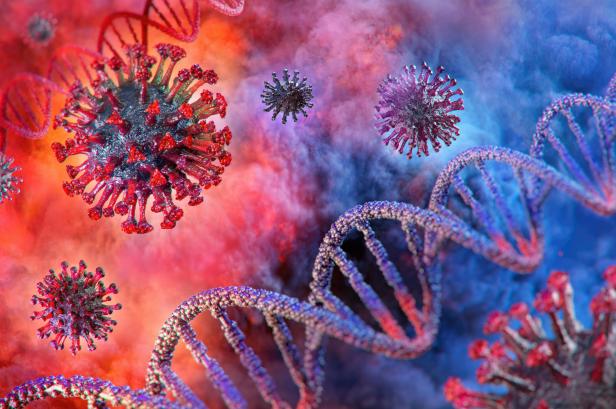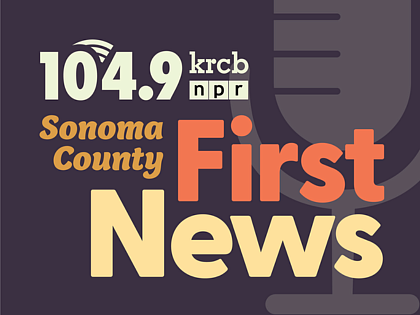
This month marks the fifth anniversary since the corona virus first started impacting our daily lives.
California governor Gavin Newsom issued a state of emergency for COVID-19 on March 4, 2020. And it was March 19 when Newsom issued an executive order insisting people to stay at home----and we went into pandemic lock-down.
Next, KRCB News Director Greta Mart checks in with Sonoma County's public health officer to learn what has changed, and where we stand after five years of COVID.
DR. KAREN SMITH: I am Dr. Karen Smith, and I am the interim health officer for Sonoma County.
GRETA MART: You weren't here 5 years ago. Could you share where you were?
DR. KAREN SMITH: I was the director of the California Department of Public Health until July of 2019. I would say also though, I do live in Napa, so I'm actually very close to Sonoma and pay a lot of attention to the North Bay.
After I left the California Department of Public Health, I actually worked for Google for a couple of years as a public health consultant if you will. They shifted a lot of energy and engineering time to trying to help build tools for public health departments around the world. And they had a deficit of people who actually had ever worked in public health. So that was my one foray into the technology sector and I have to say I learned a great deal.
GRETA MART: Fascinating.
DR. KAREN SMITH: Yeah, it absolutely was. But I formally retired from public health. I had been a local health officer for 18 years, first in Santa Clara County, then in Napa County and then I was the state health officer. And so I took retirement but then I have found many other things to do that are very interesting since that time.
GRETA MART: Okay, and how did you get to Sonoma County? To the position you're you're holding now?
DR. KAREN SMITH: Well, I actually got a request, from somebody who is there now an assistant director at the Department of Health Services, asking me if I would be willing to step in while they were doing a search for a permanent health officer and deputy health officer because both their health officer and deputy health officer had left. And I wasn't doing anything else at the time and so I said, "Yes." And it's been really fun for me to get to work back at the local level again, especially in a county that I know pretty well.
GRETA MART: Okay, got it. All right. Well, then, as you said, you paid attention. So, how do you feel we are as a county in terms of public health and COVID five years later, is there any way to quantify where we are now?
DR. KAREN SMITH: Sure. Well, there's a couple of different things I would say with respect to the virus itself, which I think is really important, the COVID viruses that are circulating now are here probably to stay, so endemic as we call it. We're seeing waves in the summer and often in the winter, although we didn't this last winter, which is very good news. This is a very different virus than the initial COVID virus that struck in 2020, 2019 into 2020. That virus was far more dangerous and if you think back, especially it started first in New York and their hospitals were overwhelmed, people were dying very quickly and in great numbers. We learned a lot about who's at risk for COVID, how to treat COVID. We have now medications that we did not have then, that you can give after exposure to COVID and that can keep you from becoming sick. We have vaccines that do a decent job of keeping you from getting severe COVID. They don't protect you necessarily fully from infection, but they do help keep people out of the hospital, especially the most vulnerable people.
So that's all I think very good news. It would be nice if COVID would go away and be one less respiratory virus, but it's acting now much more like the other respiratory viruses that we see every year including influenza, respiratory sinusitis virus, all the cold viruses as we lump them in together. It's a little more severe, it acts much more like influenza than it does any of the cold viruses, but it's so much less damaging now than it was back when we started.
GRETA MART: Is that because...that dangerous variation, did it just completely disappeared or what? Where it go?
DR. KAREN SMITH: It's a combination of factors. And this is very common, we just don't normally see it in such a dramatic fashion, but when new pathogens, things that make you sick, surge, like particularly this is true of viruses and start infecting people.
They genetically---especially viruses---replicate millions of times in every person and every time they replicate, they make slight changes to their genetic material that makes them better able to thrive in the body. But what often happens and this is what's happening with and has been happening with COVID is that yes, they may even become more infectious, but they tend to cause less illness. So they become weaker in terms of making you sick or killing you, while retaining the ability and often getting even better able to transmit. So it's a combination of of human intervention and virus change.
GRETA MART: Just thinking specifically as a county, I know that it's true that before COVID, nobody knew what a county public officer did and then suddenly they're on giving briefings every day. Where are we as a county?
DR. KAREN SMITH: Well, I'll tell you I'll give you an upside and a downside. You're right, many more people know that there is a thing called a public health officer or health officer, depending on which county you're in, and that we have something to do with public health. We also used to joke during COVID that we will never again have to tell anyone again what an epidemiologist does. Those are our data people. So when we're putting out messages, it's because we're reacting to what we're seeing in the community.
One of the positive outcomes of COVID for overall for the public health system---not just in Sonoma, but it is very true in Sonoma---is that the influx of funding to public health that came in during COVID made a huge change and a very rapid change in our ability to gather data around illness that's occurring in communities.
We have whole new tools, we have new information systems. We have been trying for 20 years in public health to get funding and and personnel to really improve our informatic systems, our ability to gather data and then analyze that data. We are light years ahead of where we were before 2019. It was truly remarkable and it's made a huge difference. We have entirely new tools like wastewater detection of viruses and and certain bacteria. So this is that has been a a very big change in it's going to really continue to evolve. Public health was never able to forecast diseases before, the way the weather men forecast what's going to happen. That's actually a very complicated process. We didn't have the capability to do that. We didn't have the data streams and we didn't have the people who could do it. Now, the CDC has an entire center that does forecasting for diseases. That's huge and it it has has positive impacts. Sonoma County has an outstanding and very versatile epidemiology team that works every single day, monitoring all kinds of disease processes.
And they do a really good job and that helps the public health officer and everyone else to understand what's happening, is flu increasing here, is or is it decreasing here? Before all of that, we were sort of waiting either for the CDC to say this is what's happening nationally, or for California Department of Public Health to say this is what is happening in California or in a region. But now Sonoma County actually has much more localized data; not for everything, but for a lot and that that's very helpful. So that's an upside. In Sonoma County, there's a downside that happened to the public health system overall, including Sonoma County, which is the polarization and politicization of public health.
Early on in COVID when people were dying and we had virtually no information about who's at most at risk, who is dying, why are they dying, where are they dying. We didn't know even much at all about the virus itself. So because people were dying at in quickly and in large numbers, public health imposed restrictions. And you know, I've been involved in pandemic planning for over 20 years now, and I've always thought when people are scared, people will go along with almost anything that you ask them to do to protect themselves and their families. But as the scare factor decreases, as we know no more, and we and we see we're having success and the inconvenience of whatever the restrictions are, whether that's staying home or wearing a mask, that increases then sentiment shifts and it shifted big time in COVID. Did we maintain those restrictions too long using what we know now? Yes, in certain cases we did.
We know that there was a a much bigger impact than people expected on children when they had to stay home and try to learn via you know using their computers. We weren't aware of that. We had we that is something that we will never do again, we have better information flows now.
So we understand what's happening, boots on the ground, who's getting sick, how are they getting sick, how can we stop it than we ever had, believe it or not, three years ago. Unfortunately, you know, politics in America has been becoming more and more polarized for a long time, long before COVID.
And now what's happened is the negative reaction to the restrictions and for some reason, masking in particular, has become a really polarizing issue. And it shouldn't be. Most of the time we don't ask people to mask, but it has really split people and that's unfortunate, And the other place that we see that actually is in vaccines, and the resistance to vaccines, which has become almost a political issue rather than a science issue. And that is really unfortunate because as we're seeing right now in Texas and New Mexico, people really do die from diseases like measles and they can be profoundly ill and have to be hospitalized. And that has ramifications not just for those kids and their families, but for communities as a whole.
GRETA MART: I'll ask you, how how are we doing in Sonoma County with kids' vaccine? Is there danger of that happening here?
DR. KAREN SMITH: So, if we look at measles, measles is probably the most infectious virus that we know. In other words, if you are exposed to measles, it takes very few virus particles to establish a infection. About 97% of people who are exposed will develop disease. That's unusual for for any virus. So it's very important that we have and oh and also people can spread the virus before they know they're sick. That's also that that's also true of COVID and that's one of the challenges that we have.
The measles vaccine is probably the best vaccine we have ever had. It's over 98% effective if you have the full course in preventing measles and the protection is lifelong with a few exceptions. There are a few people who should get boosters. That's remarkable. And so choosing not to vaccinate your child is a choice that has ramifications for the community.
Now, Sonoma County is actually doing pretty well. Overall, as a county, our vaccination rates are a little in excess of 93%. That's slightly lower than we would like to see because to have really the community-wide protection against measles in particular, you have to have 95% or higher who are vaccinated.
The thing about these numbers though is that herd protection, that protection that we talk about when we say 95%..that it only works when the people who are unvaccinated are spread evenly and that's not what happens. So Sonoma County does have some areas of the county where the vaccination rates are considerably less, and those areas are areas where measles outbreaks can occur. And that is what has happened in Texas and in New Mexico.
GRETA MART: Is that public information? Can people look up and see where they live if there's an increased danger around them or is that not public information?
DR. KAREN SMITH: It's public information. I'm not I have to say I'm not sure whether or not not that's actually on our website, but you can certainly get that. The state maintains information on vaccination levels as well. And I do know that that's some of that is available on their website. Those vaccination rates reflect school entry vaccinations, okay? So we don't know for example how many what percentage of the population's vaccinated against influenza. We make we can make guesstimate based on on how much, you know, vaccine has been used and that sort of thing. But for for the those things that in California are required for school entry, we have very good data on how what percentage of the children entering kindergarten are fully vaccinated or partially vaccinated.
GRETA MART: Interesting, Anything else you think folks need to think about at this juncture, five years later?
DR. KAREN SMITH: Something that is important is that the COVID pandemic was big and scary and has had a lot of ramifications. There are still many people who are suffering from long COVID. We still get new cases of COVID and and long COVID is a phenomenon that we don't fully understand yet. And there is still the likelihood of other pandemics occurring. We hope not. It's really important that we maintain what we call our surveillance---looking looking at the what's happening in the community so we see deviations, increases in this or decreases in that. The surveillance systems in the United states are good, much better than they were prior to COVID, but they're not sustainable without sustainable funding. And the conversation that's going on nationwide about public health and vaccines and funding the federal government...one thing that people should know is that the vast majority of funding for your local public health department comes from the federal government via the state.
So the state gets the money from the federal government and sends it out, keeps a little bit of it and sends it out to the rest of it out to the county so that we can do the work that we do to try to keep the people of Sonoma County healthy. And everything that happen in Washington---as much as they sound far away, they will have an impact. So I think as much as you may want to hide away from all the noise---and there's a lot of noise coming out of Washington these days--the decisions made there are going to have impacts here at home in Sonoma County. The other unfortunate thing that's happening, and this happens in Sonoma as well as everywhere else, is there is a tremendous amount of disinformation, which is intentionally spreading untrue information and misinformation, which is when people think some something is true and spread it and it's not. And I would say what people can do is....it's not hard to find accurate information about health issues like vaccination. It's out there, it's science-based. And so if this sort of thing concerns you, you can do some work and and and read up on it rather than getting your information exclusively from social media.I think social media is a is a great benefit in many ways and it has some real downsides. And the disinformation that's out there is, I think, one of those downsides.

 Live Radio
Live Radio




